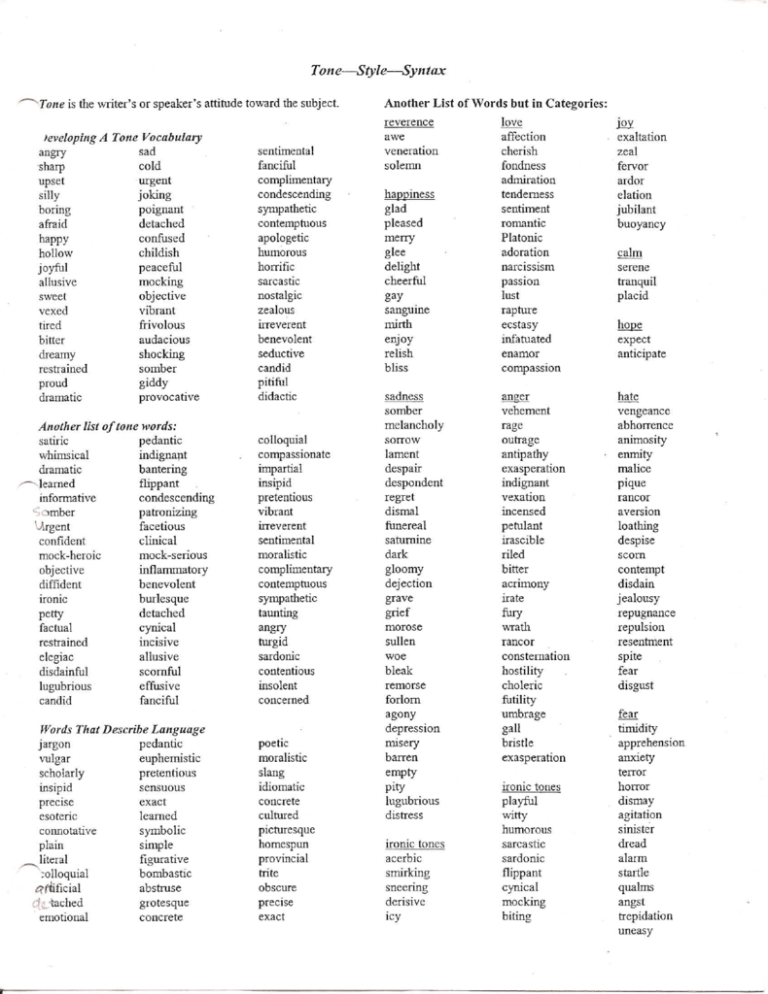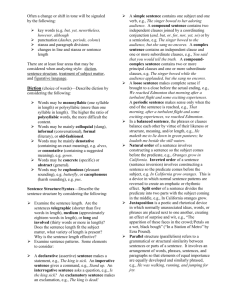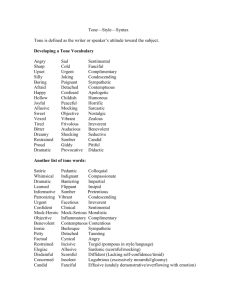Tone-Style
advertisement

Tone-Style-Syntax "'--""'Tone is the "'Titer's or speaker's attitude toward the subject. )eve/oping A Tone Vocabulary sad angry cold 'sharp urgent upset silly joking boring poignant detached afraid confused happy childish hollow peaceful joyful allusive sweet vexed tired bitter dreamy restrained proud dramatic sentimental fanciful condescending sympathetic contemptuous apologetic humorous horrific sarcastic nostalgic vibrant frivolous audacious zealous irreverent benevolent shocking seductive somber candid pitiful didactic Another list ojtolle words: satiric whimsical dramatic ,--....... learned informative S o mber \Argent confident mock-heroic objective diffident nomc petty factual restrained elegiac disdainful lugubrious candid pedantic indignant bantering flippant condescending patronizing facetious clinical mock-serious inflammatory benevolent burlesque detached cynical mcislve allusive scornful effusive fanciful Words That Describe Language jargon pedantic euphemistic vulgar scholarly pretentious insipid sensuous exact precise esoteric learned connotative symbolic plain simple figurative literal " :olloquial bombastic abstruse q rtificial grotesque C/1!3 ached concrete emotional reverence love lQY awe affection veneration solenm cherish exaltation zeal complimentary mocking objective giddy provocative Another List of Words but in Categories: colloquial compassionate impartial insipid pretentious vibrant irreverent sentimental moralistic complimentary contemptuous sympathetic taunting angry turgid sardonic contentious insolent concerned poetic moralistic slang idiomatic concrete cultured picturesque homespun provincial trite obscure prec1se exact happiness glad pleased merry glee delight cheerful gay sangume admiration fervor ardor tenderness sentiment romantic jubilant buoyancy fondness Platonic adoration narCISSIsm passIOn lust rapture elation calm serene tranquil placid mirth enJoy relish bliss ecstasy hope infatuated enamor compassIOn anticipate sadness somber melancholy sorrow lament despair despondent regret dismal funereal saturnine dark gloomy dejection grave grief morose sullen woe bleak remorse forlorn agony depression nusery barren empty pity lugubrious distress anger vehement rage outrage antipathy exasperation indignant vexation incensed petulant irascible riled bitter acnmony irate fury wrath rancor consternation hostility choleric futility umbrage gall bristle exasperation ironic tones acerbic smirking sneenng derisive ICY ironic tones playful witty humorous sarcastic sardonic flippant cynical mocking biting expect hate vengeance abhorrence animosity enmity malice pique rancor aVerSlQll loathing despise scorn contempt disdain jealousy repugnance repulsion resentment spite fear disgust fear timidity apprehension anxiety terror horror dismay agitation sinister dread alann startle qualms angst trepidation uneasy Often a change or shi ft in tone will be signaled by the fo llowing: >>>>- >- key words (e.g. but, yet, neveriheless, however, although punctuation (dashes, periods, colons) stanza and paragrap h d ivisions changes in line and stanza or sentence length There are at least four areas that may be considered when analyzing style: diction, sentence structure, treatment of subject matter, and figurative language. >D ict ion (cho ice ofwords)- Describe diction by considering the following: >- >>>>- Words may be monos yllabic (one syllable in length) or polysyllabic (more than one syllable in length) . The higher the ratio of polysyllabic words, the more difficu lt the content. Words may be mainly colloquial (slang), informa l (conversational), form al (literary), or old-fashion ed . Words may be mainly denotati ve (conta ining an exact meaning), e.g. dress, or connot ative (containi ng a suggested meaning), e.g. gown. Words may be concrete (specific) or abstract (general). Words may be euphonious (pleasant sounding), e.g. bUllerfly, or caco phono us (harsh sounding), e ..g. pus. >- >- Sentence Structure/Syntax- Describe the sentence structure by considering the fo llowing: >- >>- Examinc the sentence length. Are the sentences telegraphic (shorter than five words in length), medium (approximately eighteen words in length), or long and in volved (thirty words or mo re in length)? Does the sentence length fit the subject matter, what variety of length is present? Why is the sentence length effective? Examine sentence patterns. Some elements to consider: 'A decla r a tive (assertive) sent ence makes a statement, e.g., The king is sick. An imp er ati ve sente nce gives a comma nd, e.g ., Stand up. An interrogative sentence asks a question, e.g. , Is the king sick? An excla matory se ntence makes an exclamation, e.g., The king is dead! >- >- A simple sentence contai ns one subject and one ve rb, e.g., 77,e sil/ger bowed to her adoring audiell ce. A cO lnpound sentence contains two independent clauses jo ined by a coordinating conjunction (and, but, or,jor, nor, yet, so) or by a semicolon, e.g. The singer bowed to the audience, but she sang no encores. A compl ex sentence contains an independen t clause and one or more subordinate clauses, e.g., You said that you would tell the truth. A compoundconl plex sentence conta ins two or more principal clauses and one or more subordinate clauses, e.g. Th e singer bowed while the audience applauded, but she sang no encores. A loose sente nce makes complete sense if brought to a close before the actual ending, e.g., We reached Edmonton that morning after a turbulent flight and some exciting experiences. A periodic sentence makes sense only when the end of the sentence is reac hed, e.g., That morning, after a turbulent flight and some exciting experiences, we reached Edmonton. In a balan ced sentence, the phrases or clauses balance each other by virtue of thei r likeness or structure, meaning, andlor length, e.g., He maketh me to lie down in green pastures; he leadeth me beside the still waters. Natura l order of a sentence involves constructi ng a sentence so the subject comes before the predicate, e.g., Oranges grow in California. I nverted o rd er of a sentence (sentence inversion) involves constructing a sentence so the predicate comes before the subject, e.g. In California grow oranges. This is a device in which norma l sentence patterns are reversed to create an emphatic or rhythmic effect. Split order of a sentence divides the predicate into two parts with the subjec t coming in the middle, e.g., In Ca lifornia oranges grow. J uxtaposition is a poetic and rhetorica l device in which norma lly unassociated ideas, words, or phrases are placed next to one another, creating an effect of surprise and wit, c.g., "The apparition of these faces in the crowd;lPetals on a wet, black bough" ("In a Station of Metro" by Ezra Pound). Parallel structure (parallelism) refers to a grammatical or structural similarity between sentences o.r parts ofa sentence. It invo lves an arrangement of words, phrases, sentences, and paragraphs so that elements of equal importance are equally developed and simi larl y phrased, e.g., He was walking. running, andjumpingJor joy. ~ ~ Repetition is a device in which words, sounds, and ideas are used more than once for the . purpose of enhancing rhythm and creating emphasis, e.g., " .. . government of the people, by the people, for the people, shall not perish from the earth. A rhetorical question is a question which expects no answer. It is used to draw attention to a point and is generally stronger than a direct statement, e.g., IfMr. Ferchoff is always fair, as you have said, why did he refuse to listen to Mrs. Baldwin 's arguments? ~ Examine sentence beginnings. Is there a good variety or does a pattern emerge? ~ Examine the arrangement of ideas in a sentence. Are they set out in a special way for a purpose? ~ Examine the arrangement of ideas in a paragraph to see ifthere is evidence of any pattern or structure. Treatment of Subject Matter Describe the author's treatment of the subject matter by considering the following. Has the author been? ~ ~ ~ Subjective? Are his conclusions based upon facts; are they impersonal or scientific? Objective? Are his conclusions based upon facts; are they impersonal or scientific? Supportive of his main idea? If so, how did he support his claims? Did he: (a) state his opinions, (b) report his experience, (c) report observations, (d) refer to readings, (e) refer to statements made by experts, (f) use statistical data? ~ Personification is a kind of metaphor which gives inanimate objects or abstract ideas human characteristics, e.g., The wind cried in the dark. ~ Hyperbole is a deliberate, extravagant, and often outrageous exaggeration. It may be used either for serious or comic effect, e.g., The shot that was heard 'round the world. ~ Understatement (Meiosis) is the opposite of hyperbole. It is a kind of irony which deliberately represents something as much less than it really is, e.g., J could probably manage to survive on a salary of two million dollars per year. ~ Paradox is a statement which contradicts itself. It may seem almost absurd. Although it may seem to be at odds with ordinary experience, it usually turns out to have a coherent meaning, and reveals a truth which is normally hidden, e.g., The more you know, the more you know you don't know. (Socrates) ~ Oxymoron is a form of paradox which combines a pair of contrary terms into a single expression. This combination usually serves the purpose of shocking the reader into awareness, e.g., sweet sorrow, wooden nickel. ~ Pun is a play on words which are identical or similar in sound but which have sharply diverse meanings. Puns may have serious as well as humorous uses, e.g., When Mercutio is bleeding to death in Romeo and Juliet. he says to his friends, "Ask for me tomorrow, and you shall find me a grave man. " ~ Irony is the result of a statement saying one thing while meaning the opposite. Its purpose is usually to criticize, e.g., It is simple to stop smoking. I've done it many ~ Sarcasm is a type of irony in which a person appears to be praising something while he is actually insulting the thing. Its purpose is t6 injure or hurt, e.g., As J fell down the stairs head-first, J heard her say, "/ook at that coordination. " Antithesis involves a direct contrast of structurally parallel word groupings generally for the purpose of contrast, e.g., Figurative Language times. ~ ~ Simile is a comparison of two different things or ideas through the use of the words like or as. It is definitely a stated comparison, where the poet says one thing is like another, e.g. The warrior fought like a lion. Metaphor is a comparison without the use oflike or as. The poet states that one thing ~ another. It is usually a comparison between something that is real or concrete and something that is abstract, e.g., Life is but adrearn . ~ sink or swim. ~ Apostrophe is a form of personification in which the absent or dead are spoken to as if present, and the inanimate as if animate. Those are all addressed directly, e.g., The answer, my friend, is blowing in the wind. » » Allusion is a reference to a mythological, literary history, or Biblical person, place or thing, e.g., He met his Waterloo. Synecdoche (Metonymy) is a form of metaphor. In synecdoche, a part of something is used to signify the whole, e.g., All hands on deck. *Also, the reverse, whereby the whole can represent a part is synecdoche, e.g. Canada played the United States in the Olympic hockey finals. *Another form of synecdoche involves the container representing the thing being contained, e.g., The pot is boiling. *One last form of synecdoche involves the material from which an object is made standing for the object itself, e.g., The quarterback tossed the pigskin. *In metonymy, the name of one thing is applied to another thing with which it is closely associated, e.g., I love Shakespeare. The pen is mightier than the sword. Elements of Rhetoric Some generalizations about literature: 1. Authors usually devalue materialism. 2. As a rule, authors do not value formal religion. They do, however, generally value individual reverence. 3. Authors value mutability. 4. Authors are rarely neutral about the carpe diem theme. 5. Authors' thinking often runs counter to their own cultural training. 6. Authors are not only our social historians; they are also our social critics. 7. In the conflict between the individual and society, authors normally value the individual more than the society. 8. Most authors attack overweening pride. 9. Most authors have a critical tone toward war. 10. In much literature,. the family is a source of the most passionate kind of conflict. Words that Describe the Reader's Perception the Speaker: I. Style -/ -/ -/ -/ -/ -/ -/ -/ -/ -/ -/ -/ syntax diction point of view devices oflangnage (alliteration, assonance, etc.) tone imagery figures of speech phrasing coordination/subordination selection of detail parallelisms repetition II. Mode's of discourse (Purpose) -/ definition -/ cause/effect (causal analysis) -/ comparison/contrast -/ argumentation -/ description -/ narration -/ summary -/ persuasion (elements of logicpersuading by emotion) -/ classification/division -/ process analysis humble bold insipid Impenous austere confident credulous shallow fatuous haughty proud audacious naIve vivacious triumphant insolent SIncere vaIn gnllible Insecure innocent mane Words that describe style and syntax: plain, sparse, austere, unadorned ornate, elaborate, flowery jumbled, chaotic, obfuscating erudite, esoteric journalistic, terse, laconic harsh, grating mellifluous, musical, lilting, lyrical whimsical elegant staccato, abrupt solid, thudding sprawling, disorganized dry deceptively simple










